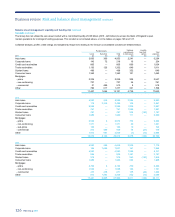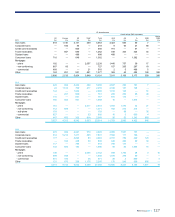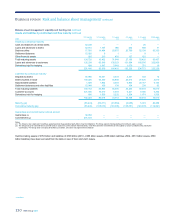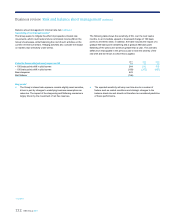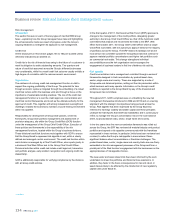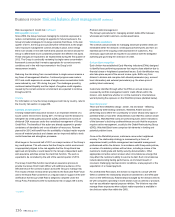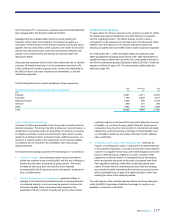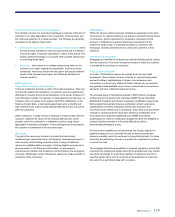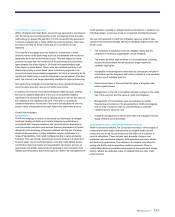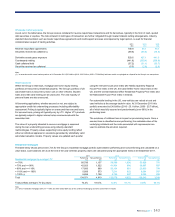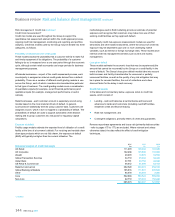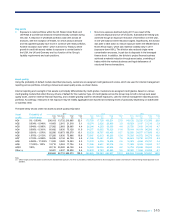RBS 2011 Annual Report Download - page 137
Download and view the complete annual report
Please find page 137 of the 2011 RBS annual report below. You can navigate through the pages in the report by either clicking on the pages listed below, or by using the keyword search tool below to find specific information within the annual report.
RBS Group 2011 135
Product/asset class concentration framework
xRetail - a formal framework establishes Group-level statements and
thresholds that are cascaded through all retail franchises in the
Group and to granular business lines. These include measures that
relate both to aggregate portfolios and to asset quality at origination,
which are tracked frequently to ensure consistency with Group
standards and appetite. This appetite setting and tracking then
informs the processes and parameters employed in origination
activities, which require a large volume of small-scale credit
decisions, particularly those involving an application for a new
product or a change in facilities on an existing product. The majority
of these decisions are based upon automated strategies utilising
credit and behaviour scoring techniques. Scores and strategies are
typically segmented by product, brand and other significant drivers
of credit risk. These data driven strategies utilise a wide range of
credit information relating to a customer including, where
appropriate, information across customer holdings. A small number
of credit decisions are subject to additional manual underwriting by
authorised approvers in specialist units. These include higher-value,
more complex, small business and personal unsecured transactions
and some residential mortgage applications.
xWholesale - formal policies, specialised tools and expertise, tailored
monitoring and reporting and, in certain cases, specific limits and
thresholds are deployed to address certain lines of business across
the Group, where the nature of credit risk incurred could represent a
concentration or a specific/heightened risk in some other form. For
example, in response to volatile conditions in the syndicated loan,
fixed income and equities markets during 2011, the Group engaged
in only selective underwriting activity in these markets. In addition to
the limit structures the Group has in place to manage its overall
exposure to underwriting activity, market-linked controls were
introduced in the loan underwriting book in 2011, to align the risk
profile more closely to asset price movements. Those portfolios
identified as potentially representing a concentration or heightened
risk are subject to formal governance, including periodic review, at
either Group or divisional level, depending on materiality.
Sector concentration framework
Across wholesale portfolios, exposures are assigned to, and reviewed in
the context of, a defined set of industry sectors. Through this sector
framework, appetite and portfolio strategies are agreed and set at
aggregate and more granular levels where exposures have the potential
to represent excessive concentration or where trends in both external
factors and internal portfolio performance give cause for concern. Formal
periodic reviews are undertaken at Group or divisional level depending on
materiality. These may include an assessment of the Group’s franchise in
aparticular sector, an analysis of the outlook (including downside
outcomes), identification of key vulnerabilities and stress/scenario tests.
Specific reporting on trends in sector risk and on status versus agreed
appetite and portfolio strategies is provided to senior management and to
the Group Board.
As a result of the reviews carried out in 2011, the Group has reduced its
risk appetite in the higher-risk sectors of leisure, media, commercial real
estate, construction, automotive, and airlines and aerospace.
In response to the severe budgetary cuts mandated by the UK
Government in 2010, the UK and Northern Ireland teams conducted a full
review of the likely impact of the austerity measures on their corporate
and retail lending portfolios. Areas of specific focus, such as local
authority lending, where budgetary pressures will be hard felt, and
portfolios exposed to discretionary consumer spend, such as the retail
and leisure industries, were stressed using downside assumptions on
further house price deterioration and higher unemployment. The output of
these activities was reviewed by the Executive Risk Forum and actions
agreed in the event that these scenarios threaten to materialise.
The impact of the eurozone crisis has been felt most significantly in the
financial institutions sector, where widening credit spreads and regulatory
demand for increases in Tier 1 capital have exacerbated the risk
management challenges already posed by the sector’s continued
weakness, as provisions and write-downs remain elevated. A material
percentage of global banking activity in risk mitigation now passes
through the balance sheets of the top global players, increasing the
systemic risks to the sector. The Group’s exposures to these banks
continue to be closely managed. The increased use of central clearing
houses to reduce counterparty credit risk, including settlement risk,
among the larger banks is a welcome move but one that will bring its own
challenges. The weaker banks in the eurozone have also been the
subject of heightened scrutiny and the Group’s risk appetite for these
banks was adjusted continuously throughout 2011.
Single name concentration framework*
Within wholesale portfolios, much of the activity undertaken by the credit
risk function is organised around the assessment, approval and
management of the credit risk associated with a borrower or group of
related borrowers.
Aformal single name concentration framework addresses the risk of
outsized exposure to a borrower or borrower group. The framework
includes specific and elevated approval requirements, additional reporting
and monitoring, and the requirement to develop plans to address and
reduce excess exposures over an appropriate timeframe.
Credit approval authority is discharged by way of a framework of
individual delegated authorities, which requires at least two individuals to
approve each credit decision, one from the business and one from the
credit risk management function. Both parties must hold sufficient
delegated authority under the Group-wide authority grid. Whilst both
parties are accountable for the quality of each decision taken, the credit
risk management approver holds ultimate sanctioning authority. The level
of authority granted to individuals is dependent on their experience and
expertise, with only a small number of senior executives holding the
highest authority provided under the framework. Daily monitoring of
individual counterparty limits is undertaken.
At a minimum, credit relationships are reviewed and re-approved
annually. The renewal process addresses: borrower performance,
including reconfirmation or adjustment of risk parameter estimates; the
adequacy of security; and compliance with terms and conditions. For
certain counterparties, early warning indicators are also in place to detect
deteriorating trends in limit utilisation or account performance, and to
prompt additional oversight.



